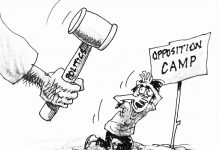In Eastern Visayas, ghost projects are far from being rumors—they are for real. From provincial highways to barangay-level footpaths, paper roads and phantom buildings have bled public funds dry while communities remain stuck in poverty. This is corruption in its ugliest form, and it must no longer be tolerated.
Anyone who has lived long enough in the region knows how ghost projects operate. They begin with project proposals that sound noble and necessary—farm-to-market roads, multipurpose halls, school buildings, water systems. The budget is approved, the funds are released, but the project either never materializes or exists only in a token form: a half-poured foundation, a rusting post, or a short gravel strip that leads nowhere. On paper, it is complete. In reality, it is a monument to theft.
Barangays, the smallest units of government closest to the people, have not been spared. There are cases where barangay funds have been appropriated for projects that villagers never even saw. Sometimes the name of a barangay is used in liquidations and reports, yet when residents are asked, they shake their heads in disbelief—no such project was ever done. This is not just stealing; it is mockery. It insults both the people and the very concept of governance.
The culprits are not ghosts but flesh-and-blood politicians and contractors who have mastered the art of vanishing money. They thrive on a system where signatures matter more than substance, where inspection reports are signed without inspection, and where collusion between officials and contractors is treated as normal. These are not mere lapses; they are carefully orchestrated crimes that strip resources from the poor while fattening the pockets of the already powerful.
The irony is stark: Eastern Visayas, a region that has endured calamities and is in dire need of infrastructure and services, suffers from deliberate sabotage by those entrusted to rebuild it. The typhoons tear down homes, but it is corruption that ensures they are never rebuilt properly. Ghost projects do not simply steal money—they steal opportunities, delay progress, and deepen the misery of the people who deserve better.
Accountability must be the weapon against this plague. Those involved should be dragged into the courts, not coddled in political alliances. Dismissal from service is the least punishment for officials who betray their mandate. Private contractors who conspire in this racket should be blacklisted permanently, stripped of the privilege of ever handling public funds again. Anything less is complicity, a wink at corruption disguised as governance.
One wonders how many school children could have studied in safe classrooms, how many farmers could have reached markets faster, how many communities could have had clean water, if not for these shameless ghost projects. This is why tolerance of such thievery is not just negligence—it is cruelty. It tells the poor they are meant to remain poor, while their supposed leaders live off stolen riches.
The fight against ghost projects in Eastern Visayas must not stop at exposure. It must be pursued with the ferocity of people tired of being fooled, demanding proof of real work before the release of funds, and insisting on citizen oversight in every barangay. Ghost projects must be exorcised, and public service returned to the living, breathing people who own it.




